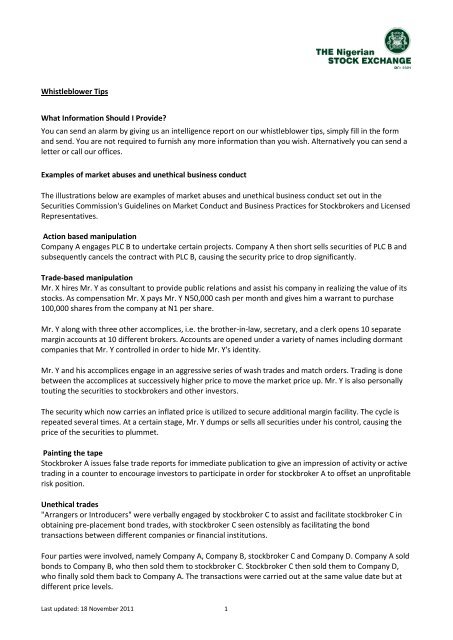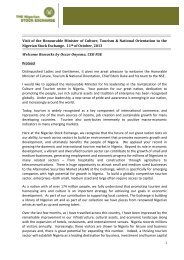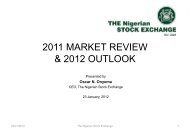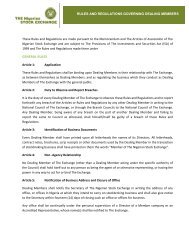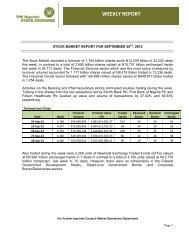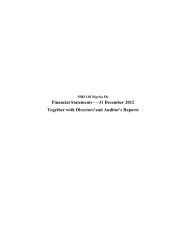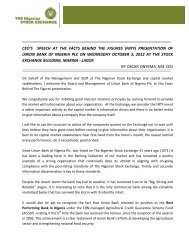Whistleblower Tips What Information Should I Provide? You can ...
Whistleblower Tips What Information Should I Provide? You can ...
Whistleblower Tips What Information Should I Provide? You can ...
You also want an ePaper? Increase the reach of your titles
YUMPU automatically turns print PDFs into web optimized ePapers that Google loves.
<strong>Whistleblower</strong> <strong>Tips</strong><strong>What</strong> <strong>Information</strong> <strong>Should</strong> I <strong>Provide</strong>?<strong>You</strong> <strong>can</strong> send an alarm by giving us an intelligence report on our whistleblower tips, simply fill in the formand send. <strong>You</strong> are not required to furnish any more information than you wish. Alternatively you <strong>can</strong> send aletter or call our offices.Examples of market abuses and unethical business conductThe illustrations below are examples of market abuses and unethical business conduct set out in theSecurities Commission's Guidelines on Market Conduct and Business Practices for Stockbrokers and LicensedRepresentatives.Action based manipulationCompany A engages PLC B to undertake certain projects. Company A then short sells securities of PLC B andsubsequently <strong>can</strong>cels the contract with PLC B, causing the security price to drop signifi<strong>can</strong>tly.Trade-based manipulationMr. X hires Mr. Y as consultant to provide public relations and assist his company in realizing the value of itsstocks. As compensation Mr. X pays Mr. Y N50,000 cash per month and gives him a warrant to purchase100,000 shares from the company at N1 per share.Mr. Y along with three other accomplices, i.e. the brother-in-law, secretary, and a clerk opens 10 separatemargin accounts at 10 different brokers. Accounts are opened under a variety of names including dormantcompanies that Mr. Y controlled in order to hide Mr. Y's identity.Mr. Y and his accomplices engage in an aggressive series of wash trades and match orders. Trading is donebetween the accomplices at successively higher price to move the market price up. Mr. Y is also personallytouting the securities to stockbrokers and other investors.The security which now carries an inflated price is utilized to secure additional margin facility. The cycle isrepeated several times. At a certain stage, Mr. Y dumps or sells all securities under his control, causing theprice of the securities to plummet.Painting the tapeStockbroker A issues false trade reports for immediate publication to give an impression of activity or activetrading in a counter to encourage investors to participate in order for stockbroker A to offset an unprofitablerisk position.Unethical trades"Arrangers or Introducers" were verbally engaged by stockbroker C to assist and facilitate stockbroker C inobtaining pre-placement bond trades, with stockbroker C seen ostensibly as facilitating the bondtransactions between different companies or financial institutions.Four parties were involved, namely Company A, Company B, stockbroker C and Company D. Company A soldbonds to Company B, who then sold them to stockbroker C. Stockbroker C then sold them to Company D,who finally sold them back to Company A. The transactions were carried out at the same value date but atdifferent price levels.Last updated: 18 November 2011 1
The bond transactions mentioned above would result in Company A incurring an "opportunity loss", whichaccrued to the other parties involved. In other words, the other parties profited at the expense of CompanyA.Profits from the bond trades would then be shared between stockbroker C and the "Introducers", where the"Introducers" received signifi<strong>can</strong>t profits from the bond trades.In this case, stockbroker C is used as a conduit or "middle person" to take advantage of opaque two-wayquotes in bond trades to benefit its clients by executing the deals at the expense of the initial bondbuyer/seller where the latter did not get the best price.RolloverSBC A executed several married deals where the purchase and sale of securities did not involve any changein the beneficial ownership. The married deals were performed to give clients a deferment on settlementtime for outstanding purchases (rollover).The quantity and price of the securities transacted would be similar to the initial contract. However, thesettlement period (due date) had been extended and additional brokerage was charged on clients for eachrollover executed by the company.Hence, the deals were transacted through the sales and purchases of securities without any change inbeneficial ownership of the said securities.Third party paymentStockbroker A was instructed by Client A to purchase 10 million units of PLC P's securities on behalf of ClientB from Client C. At settlement, Client A instructed stockbroker A to utilize Client C sales proceed to set-offagainst the purchases made by Client B.The sale of PLC P's securities may not have involved a change in beneficial ownership of securities, as ClientA had an interest in the securities before the purchase, and Client A had control over or was able to exertinfluence on Client B and/or Client Cover the securities.Marking the closeA remise of stockbroker A assisted several clients by placing orders at the close of trading day, which causedthe price of securities to move higher than the prior sales price. Simultaneously, orders at prices which arehigher than the previous bid or lower than the previous offer were entered, and withdrawn before theycould be executed, in order to give a misleading impression that there was demand for or supply of thesecurities at that price.Front runningDealer's representatives handling accounts of several big institutions/retail clients executed trades for theirindividual clients or accounts of related persons prior to the execution of trades of the big institutions/retailclients, with the view to front run and make quick profits.ConflictsA person with knowledge of a favorable or unfavorable research report purchases or sells securities inadvance of the report being released.ScalpingThe person trading is also responsible for giving buy or sell recommendations, e.g. purchases a securityLast updated: 18 November 2011 2
efore recommending the security, and then sells the security at a profit upon the rise in the market pricefollowing the recommendation.SpoofingA person submits a large but not marketable limit order that raises the bid price of a security and/or greatlyincreases the quoted size at or around the current best bid price. The large order causes Market Participantsto match or better the price of the order. The person then <strong>can</strong>cels the large order and enters (virtually at thesame time) a sell order that matches the buy order of other investors at a higher price.This is manipulation by "spoofing". By temporarily manipulating the bid price upward, and causing other bidsand trading interest at that level, the person receives a better price for his security than what would havebeen the prevailing market price and/or volume if the person's large order had not been entered.Spoofing is also used to manipulate the opening price of a security; e.g., via entry and immediate<strong>can</strong>cellation of lower priced sell orders with the objective of creating a more favorable buying opportunityfor the manipulator.Pump and dumpA person takes a long position in a security and disseminates misleading information about the security toinflate its price then disposes it at a higher price.Illustration 13 - Trash and cashA person takes a short position in a security and disseminates misleading negative information about thesecurity to depress its price and to buy it at a lower price.Surveillance Glossary Bear RaidTaking over a company by manipulating its stock price, by first selling (to lower the price), and thenrepurchasing at the lower price. CappingManipulating stock prices (lowering or maintaining) in order to influence the exercise of an existing optionsposition. PeggingManipulating the price of a stock (raising or maintaining) in order to influence the exercise of an existingoptions position. Manipulation Prior to the Pricing of Related ProductsManipulating certain stocks that influence the price of other stocks or related financial products. Mini-ManipulationManipulating the price of an option on a stock by manipulative trading in the underlying stock. Overtrading (Securities Taken In Trade)If a broker-dealer purchases (or arranges the purchase of) securities taken in trade (swaps) notat the current fair market price. The purchases are usually for a fixed price offering,Last updated: 18 November 2011 3
Wash SaleGiving the impression of high trading activity by buying and selling the same stock at the same price, throughthe same broker-dealer. Improper ExecutionAs opposed to "best execution," the execution at unfair prices such that the buyer (seller) does not incur thelowest (highest) reasonable cost. Improper execution <strong>can</strong> be due to an improper spread (the differencebetweenthe inter-dealer best bid and best offer); an improper markup (the amount charged to the buyer's cost in aprincipal trade over the best inter-dealer offer); or an improper markdown (the amount deducted from theseller's proceeds below the highest inter-dealer bid).In other cases, many individuals or companies wereinvolved that caused the alert. Some of these illegal activities that <strong>can</strong> be the cause of the trades include:Activities to be detected through Suspicious Patterns of Name Associations Acting in ConcertTwo or more persons working together to gain control of a company or manipulate the price of a security. Cornering the MarketTwo or more persons working together to inflate the price of a stock, by acquiring a very large position in thesecurity. CollusionTwo or more persons working together so as to create a false impression of market activity orto artificiallyinterfere with supply and demand. Typical activities include making agreements to fix prices or otherwisecontrol a market (likely to violate anti-trust laws, aside from industry rules and regulations); overbidding byentering unauthorized or inflated orders or indications of interest; evading credit restrictions or reportingrequirements or to conceal or disguise the true ownership of securities; facilitating or aiding in any of theabove or similar activities. Daisy ChainA pattern of fictitious trading by a group of persons for the purpose of manipulation: the group profits whenan unsuspecting person “bails out” the group. Front-RunningSomeone (with knowledge of an imminent transaction) buying or selling a stock (or option or index in thatstock) in order to take advantage of the information. Insider TradingSomeone (with non-public knowledge of a company) buying or selling a stock (or option or index in thatstock) in that company in order to take advantage of this non-public knowledge. ParkingHiding the true ownership of securities (and thereby avoiding fees, legal disclosures, capital requirements,anti-trust filings, or to extend financing otherwise prohibited), by creating a set of fictitious transactions andtrades. Pre-arranged TradesTransactions in which the price, terms or contra-side have been prearranged and which are not subject tonormal market risk. The transactions may be illegal under both securities and tax laws.Last updated: 18 November 2011 4
Year End and "As Of" TradesTransactions executed at year end or as of a particular date in order to establish gains or lossesfor taxpurposes or conceal portfolio losses or true positions from accountants, auditors or regulators. These tradesmay violate regulatory prohibitions against prearranged trading and may result in allegations of parking. Marking the CloseTransactions executed at or just before the market close to print favorable prices for inappropriatepurposes, such as inflating position valuations or avoiding margin calls. RumorsStarting or spreading rumors in order to influence the price of a stock. Short SqueezePersons who sell a security short paying inflated prices, because the price of a stock was inflated by someoneLast updated: 18 November 2011 5


